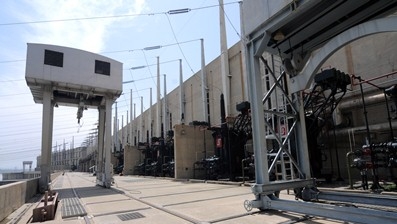TARBELA DAM, Pakistan – When daily power cuts darken their homes, Syed Munsif Shah’s neighbors no longer stare in frustration at Pakistan’s largest dam looming beyond their village.
“Now we know to be patient, that good things are coming with fresh changes at Tarbela Dam,” says Munsif Shah. “In fact, when we look at the dam, we feel pride because we are contributing to our nation.”
Soon, Munsif Shah and his friends, who live in a tiny hamlet called Ghazi just seven kilometers from the dam, will be among the hundreds of workers helping to build an additional hydropower plant at the dam.
Originally constructed in 1974, the Tarbela Dam (map) is the world’s largest earth- and rock-filled structure, standing almost 500 feet high and straddling the Indus River for 9,000 feet. Its existing hydropower facilities supply about 16% of the electricity generated in Pakistan.
But in recent years, the country’s demand for power has risen so dramatically that supply can’t keep up. Load shedding has caused widespread blackouts that reached peak levels in 2011 when power cuts occurred in homes, businesses, factories and industries for an average of eight hours daily. In summer, cuts reached 16 to 20 hours in some areas.
The disruption is causing widespread protests, even violence, particularly in major cities like Karachi and populous areas like Punjab province.
Even in Munsif Shah’s little hamlet just down the road from the dam, load shedding can occur for four to six hours daily, he says. “In our area, there is not quite the same hue and cry, although people do complain because we live so close to the source, but we also know we have been lucky.”
Now they hope the latest expansion plan will benefit them and millions of others across Pakistan.
Called the Tarbela Fourth Extension Project, the plan is to increase the dam’s ability to produce electricity by more than a third (by adding 1,410 megawatts of generating capacity to the current hydropower capacity of 3,478 megawatts).
The new hydropower plant will be added to an existing water tunnel at the northeast end of the dam. Since much of the necessary infrastructure is already in place, costly construction, along with many social and environmental challenges often linked with large dam projects, will be avoided. Construction is expected to be completed in 2018.
The World Bank is contributing funds to the powerhouse extension project.
Gazing past the gravel-covered slope of the dam, where an arrangement of white boulders proclaim the Quran verse: “And He Hath Made Rivers for Service unto You,” Hazrat Omar, Tarbela’s general manager and project director, notes that the additional power plant will especially benefit the impoverished of Pakistan because electricity prices should decline.
“When more power is added, electricity costs will go down,” said Omar. “This will definitely have a positive impact on the poor.”
The increase in water-generated power will also further shift the mix of Pakistan’s generation capacity away from expensive imported fuel oil needed to run thermal plants. “This will be a cleaner, more environmentally friendly source of power,” Omar said.

